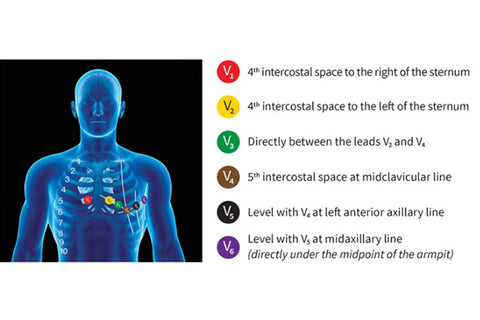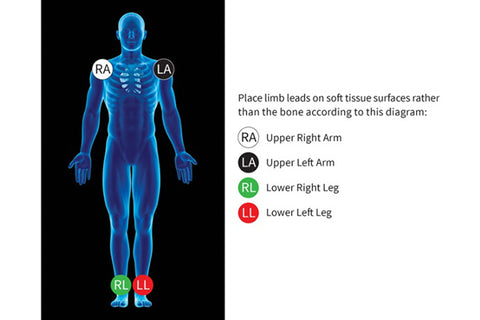An ECG stands for electrocardiogram. It is a tool used to detect a wide range of heart dysrhythmias using waveforms on a monitor. It is used by healthcare providers regularly both in the hospital and by EMS.
How to do the 12-ECG Placement? Here’re simple steps below.
Step 1:Make Sure Patient Positioning for 12-Lead ECG Placement

Ensure that electronic devices (e.g. smartphone) are removed from the patient. These devices can produce artifact (interference) and cause problems with the readings.

Place patient in supine or Semi-Fowler's position. If both positions are impossible, you can perform ECG with the patient in a more elevated position.

With arms lying flat on the side, ask the patient to relax the shoulders and keep the legs uncrossed.

For patients that do not fit comfortably on the bed or exam table due to size, ask them to cross their arms on their stomach to reduce muscle tension and movement.

Unless you're performing a stress ECG test, ask the patient to lie still and quietly until the test is done.
Step 2:Prepare the Skin

Skin should be dry, hairless, and oil-free. Shave hair that can possibly impede electrode placement. Electrodes should have full contact with the patient's skin.

For better electrode adhesion and oil-free skin, rub the area with an alcohol prep pad or gauze paid with benzoin tincture.

Reduce electrical resistance minus the skin redness with 5 to 10 gentle strokes. This will help ensure that the heart's electrical signals are transmitted to the electrodes.

Promote an environment that prevents the patient from sweating profusely.
Step 3:Find and mark the placements for the electrodes


Exact placement of each electrode on the patient is important. Incorrect placement can lead to false or misleading diagnosis.

Make sure the electrode conducting gel is fresh and adequately moist. A dry electrode with inadequate gel reduces the conduction of the ECG signal.

Often, electrode gel dry-out is a result of incorrect storage. Store electrodes as instructed by manufacturer and do not remove from their pouch until they're ready for use.

Do not place electrodes on skin over bones, incisions, irritated skin, and body parts where there is lots of possible muscle movement.

Use electrodes of the same brand. Using different brands with dissimilar composition can hinder an accurate ECG trace.
ECG Best Practices:

Always protect the patient’s privacy and dignity by draping with a sheet to minimize exposure.

Lead placement and patient positioning should be the same for subsequent ECGs on any individual patient.

During the procedure, record any clinical signs (e.g. chest pain) in the notes or on the ECG tracing itself.





1 comment
very nice service